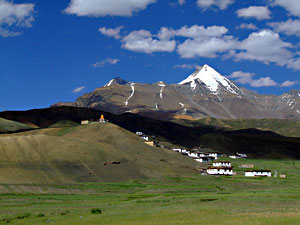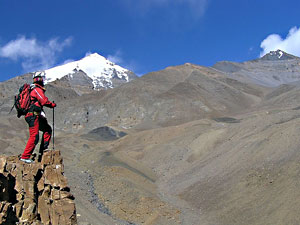|
|
|
Spiti,
Himachal Pradesh |
|
|
|
General Information about Spiti
Area: 4800 square kms.
Clothing: Light woolen in Summer, Heavy woolen
in Winter.
Temperature: Maximum:26.8 C Min 1.38 C Summer
Maximum: 6.1 C Min (-)19.38 C Winter
Best Season: May to October
Languages: English, Hindi, Bhoti
Religion: Hinduism and Buddhism
Information about Spiti
Spiti is the sub division of Lahaul and Spiti district
with its headquarters at Kaza. It is called 'Little
Tibet' because it has almost the |
 |
|
|
same terrain,
vegetation and climate like Tibet. Spiti also means 'Middle
Country'. Spiti is linked to the Lahaul valley by the Kunzam-la
pass. The main Spiti valley is split into eastern and western
valleys. It is connected with Ladakh and Tibet on eastern side
and Kinnaur and Kulu on western side through high passes. From
Shimla via Kinnaur there is a motorable road which remains
open upto Kaza for 8 to 9 months. About 10 kms. ahead of Pooh,
Satluj river enters India near Shipki la and Spiti river joins
it at Khab. The road then goes to Sumdo via Hangrang valley.
From Sumdo Spiti valley starts. Spiti is a vast highland basin
for swift flowing glacial streams that have cut deep gorges
into the mountain terrain. Pin and Lingti are the two main
streams that feed the Spiti River. The narrow Spiti Valley is
carved out by the swift flowing Spiti River and rise from the
slopes of the Kunzam-la Pass. This valley is formed by the
gorges and dramatic mountains. The valley is not wide
but there are some villages and fields which are located along
its wider banks. The people grow barley, buck-wheat, peas,
vegetables in the fields. It has an area of 4800 square kms.
In summer, there is greenery all over the Spiti valley, and
all the meadows are covered with flowers. The terraced fields,
trees of juniper and flat roofed houses are set against the
background of rocky mountain sides that seem painted in shades
of purple and pink.
People of Spiti
The people of Spiti are charming, simple, friendly, hospitable
and honest. Some people have adopted Buddhism as their faith.
The people of Spiti speak Bhoti, Hindi and English languages.
Their songs and dances are pure as the snow around them and
their "Gompas" are the collection of Buddhist treasures. |
|
|
|
Trekking in Spiti
Manali in the Kullu Valley serves as base for supplies and
equipment for treks in the Lahaul and Spiti area and many
exciting treks that originate in Kullu Valley terminate in
Spiti. A favourite trek in this area is the 4 stage moderate
trek that start from Batal in Southern Lahaul at the base of
the Kunzam la, to the beautiful lake of Chandratal and ends at
the Baralacha-la pass. Over a part of the way this route
overlooks the magnificent Bara Shigri glacier. Taking 8
strenuous stages another trails starts from Udaipur in Upper
Lahaul to Padum in Zanskar over the Kang-la pass.
|
 |
|
|
|
|
Best time to visit Spiti
Both, the Lahaul and Spiti valley remains cut off from the
rest of India for most of the part of the year. The Rohtang
Pass is opened only from May to October and so during this
time the visitors can visit the Spiti valley to enjoy its
beauty.
Tourist Attractions in Spiti
The main tourist attraction in Spiti are the Dhankar
Monastery, Tabo Monastery, Ki Monastery. The other places
which can be visited in Spiti are Thang Yug Gompa, Kungri
Gompa, Kunzam Pass, Losar, Kaza and Kibber. Ki Monastery is
the oldest and biggest monastery of the valley and located
above Kye village. It houses beautiful scriptures and
paintings of Buddha and other goddesses. Dhankar Monastery has
about 100 Lamas and collection of Buddhist scriptures in Bhoti
language. Principal figure is a Statue of " Vairochana" (Dhayan
Buddha) consisting of 4 complete figures seated back to back.
Tabo monastery, the 1000 year old monastery, is the Spiti’s
most sacred monastery. This monastery is a treasure house of
art and was built at the initiative of the great teacher
Rinchen Tsang Po in 996, the Tibetan Year of the Fire Ape.
Kunzum pass is the gateway to Spiti from Kulu and Lahaul.
More....
How to reach Spiti
Spiti can be visited by road from Manali via Rohtang Pass to
Kaza, the headquarters of Spiti. The Manali – Leh highway, one
of the highest mountain road in the world, and is open for 3
months in the year from early June to September. Manali is
linked by road and air to Chandigarh, Shimla and Delhi. To
enter the Spiti Valley, one has to cross the Kunzam Pass, at a
height of 14,800 feet. The longer but popular route into the
valley is along the old Hindustan – Tibet road from Shimla
across the scenic district of Kinnaur. |
|
|
|
|
|